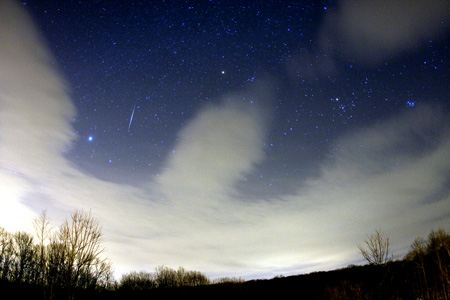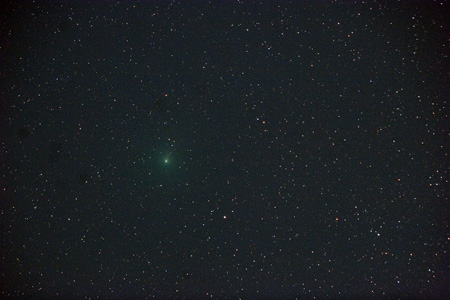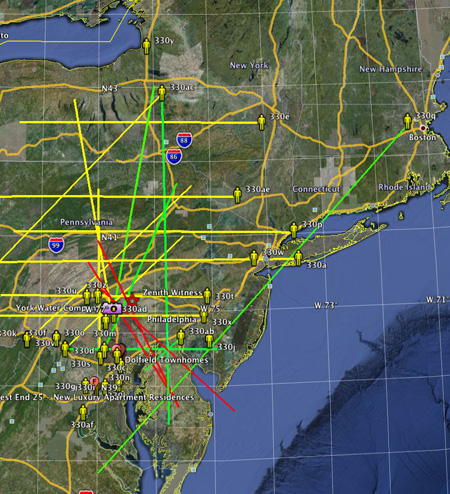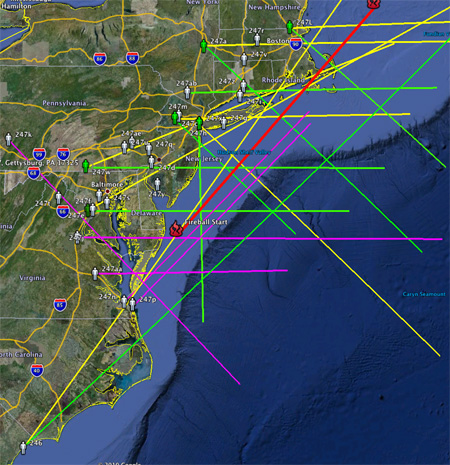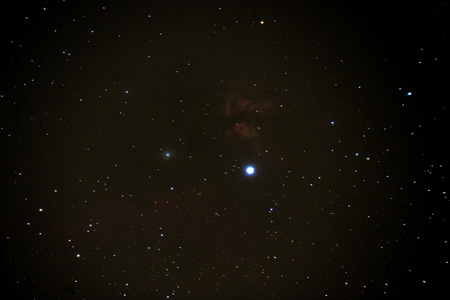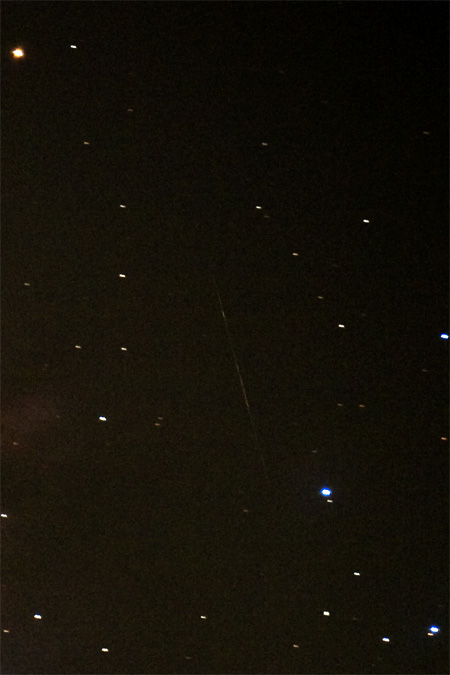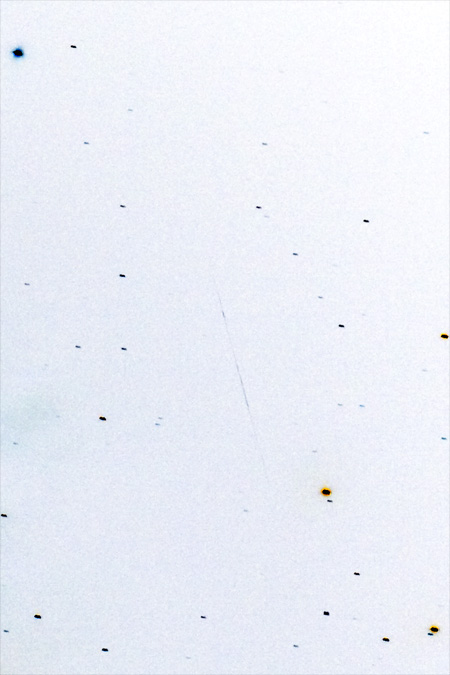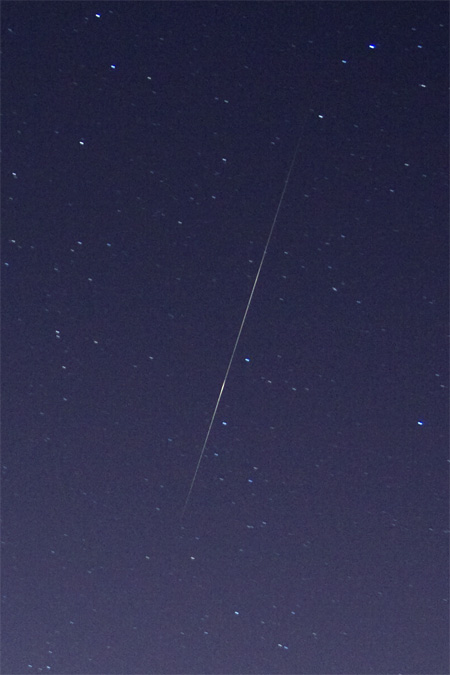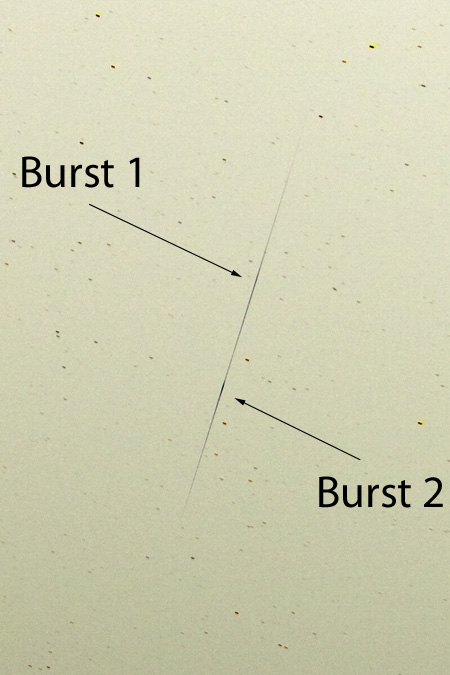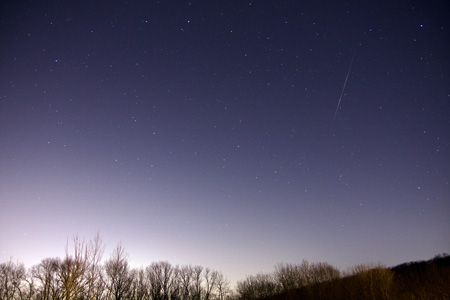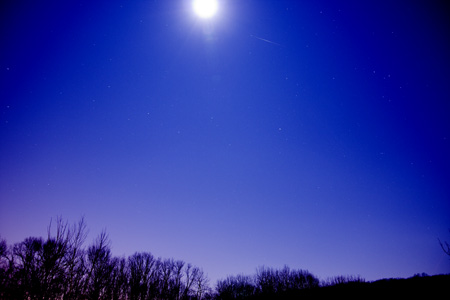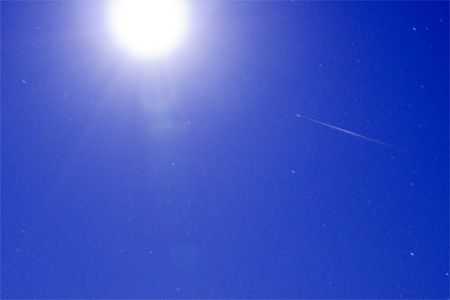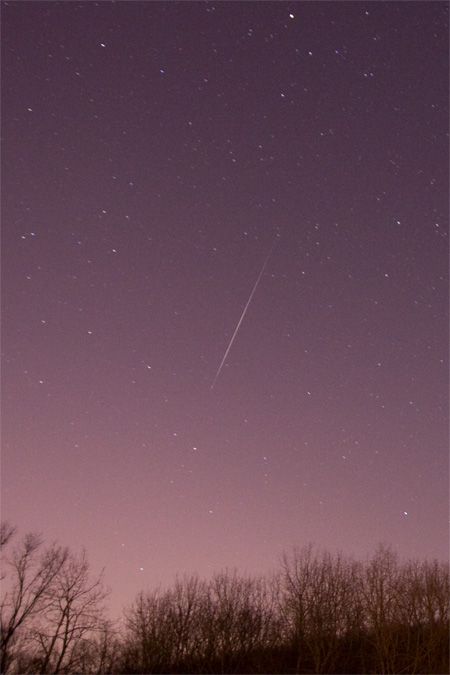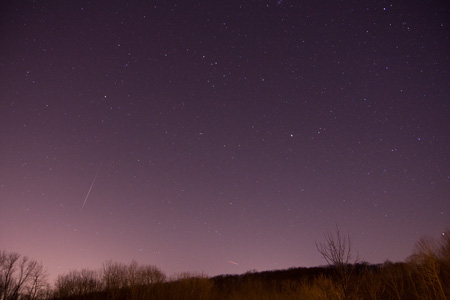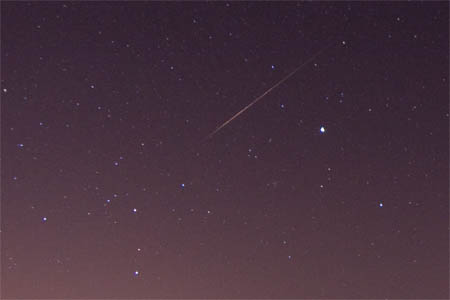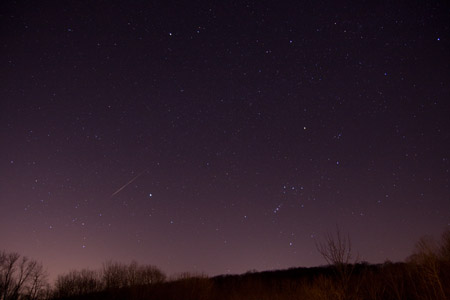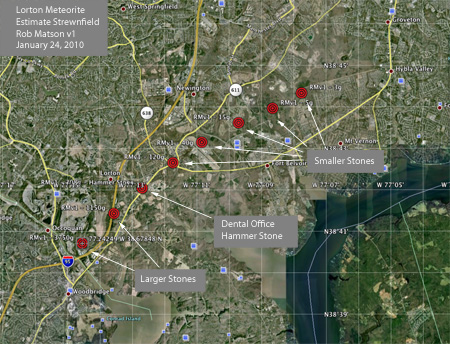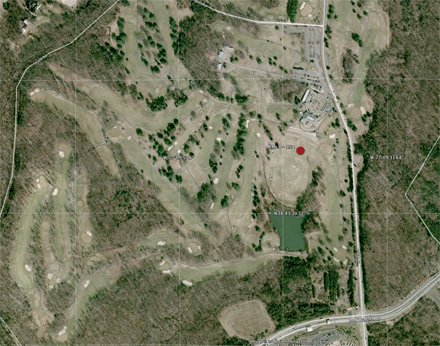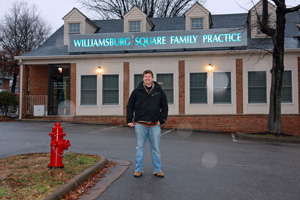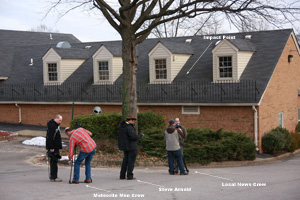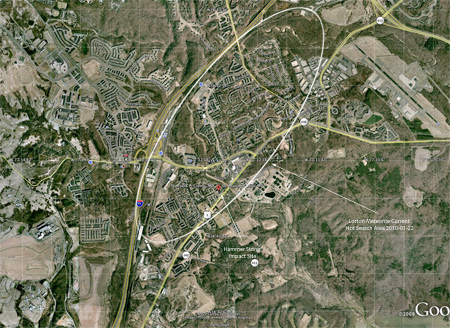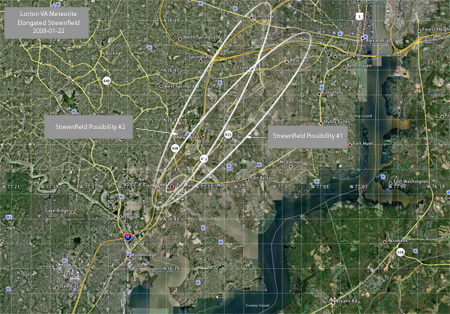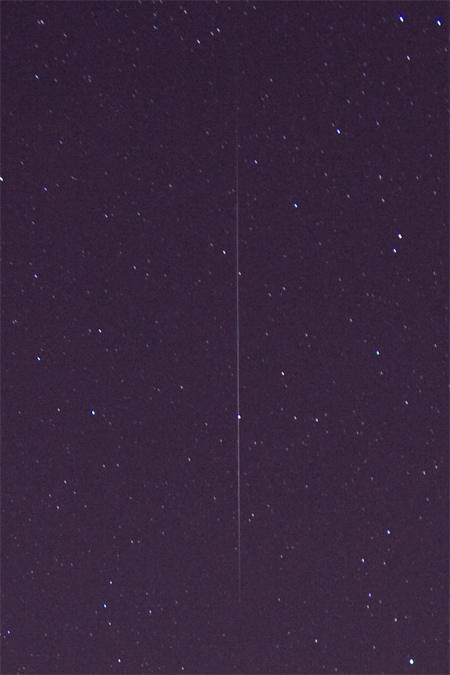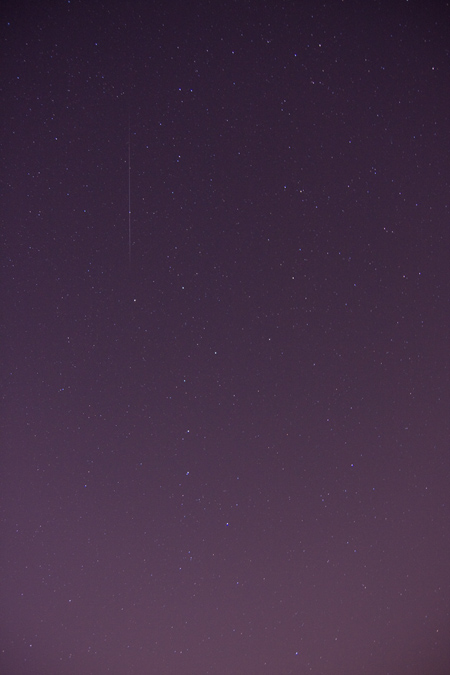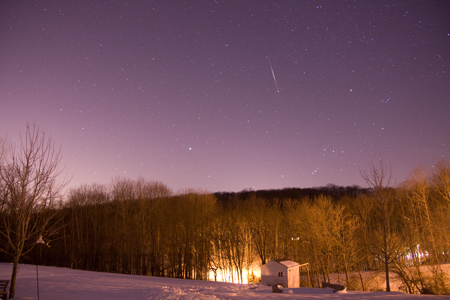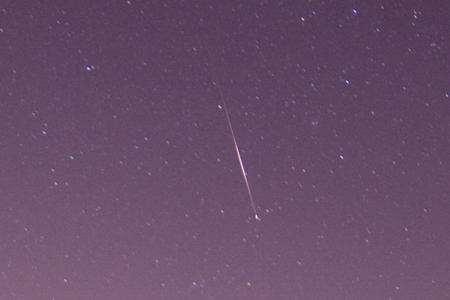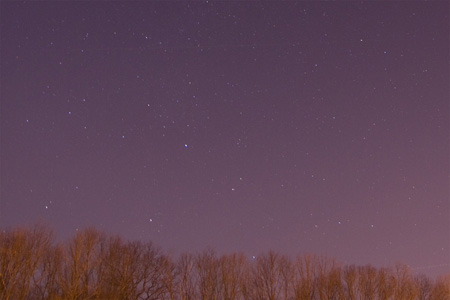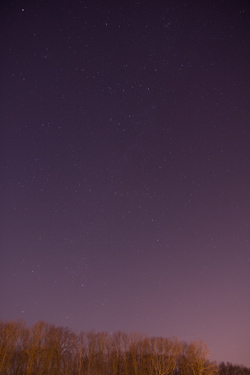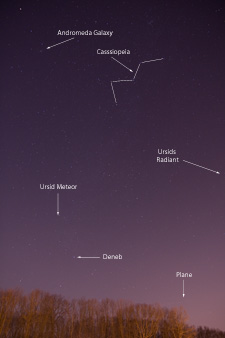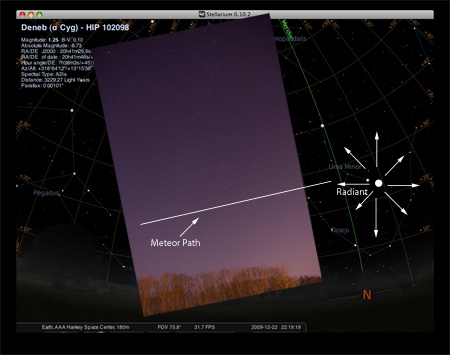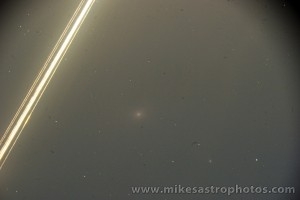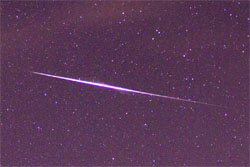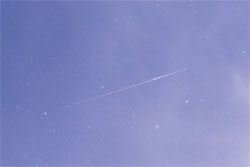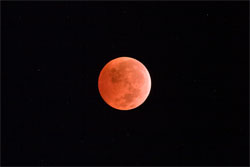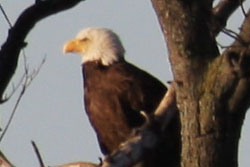Comets & Meteors
Geminids 2010
by Mike Hankey, under Comets & Meteors
The Geminid Meteor Shower peaked before dawn this morning and observers around the globe are reporting one of the best showings in years boasting rates of over 100 meteors per hour. The east coast and much of the country was under clouds and snow storms. I setup my camera while it was cloudy hoping conditions might change. Fortunately between 2:30-4 am the clouds cleared up a bit and in that 1.5 hours I photographed 13 meteors. Its cloud tonight, but I’m trying the same plan again. Here’s one of the photos from last night. I’m still processing the other pictures and will post more later.
Geminid Meteor Shower This Week
by Mike Hankey, under Comets & Meteors
The Geminid Meteor Shower, one of the best showers of the year peaks this Tuesday right before dawn. If you have clear skys this weekend and over the next few days take time to look up for a few hours.
http://www.usatoday.com/tech/science/2010-12-10-geminid-shower_N.htm
Breaking News: Fireball in Baltimore MD and York PA Nov 12, 2010 8:30 PM
by Mike Hankey, under Comets & Meteors
I was on my way home from meteorite hunting when I got a call from a neighbor in Freeland MD. He said he had just witnessed a huge fireball from the south-south-east headed to the north. The time was 8:30 on November 12th. He said it left a trail across the sky that stayed illuminated for several seconds after the meteor passed. It was bright enough to lighten the ground of the deck where he was standing. Based on his report it sounds like it would have started over Baltimore MD and ended in Harrisburg PA. I will post more information as it becomes available. Any witnesses to this event are encouraged to submit their account to the American Meteor Society Fireball Report.
Comet Hartley 2 – 103P/Hartley
by Mike Hankey, under Comets & Meteors
Comet Hartley 2 was as close as it gets to Earth last week. I snapped these pictures the night after the peak (as peak night was cloudy.)
Here’s an animated GIF of a sequence of images taken over a 45 minute time period. Clouds were coming and going so I had to drop some frames at the beginning of the animation. The line that goes through one of the frames is a satellite.
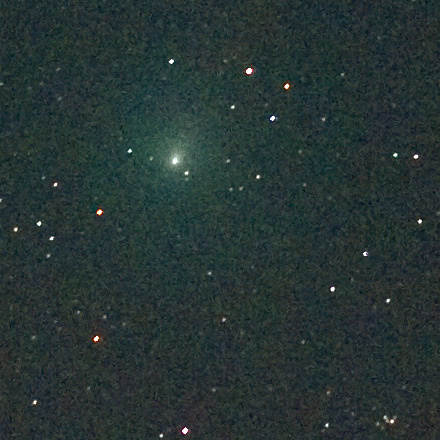
Comet Hartley 2 - Oct 22, 2010 16:26 - 17:17 UTC
The really really exciting thing about this comet is: NASA’s Jet Propulsion Laboratory is currently operating the EPOXI mission and one of the goals of this mission is to send a NASA probe (space ship) on a close fly by of this comet. This fly by is scheduled to take place in just a few days. You can read more about the EPOXI mission here.
Photo Details
William Optics FLT 98 / CGEM Mount
Canon 20Da Camera
No Auto Guider
30 second ISO 400 exposures
No stacking / no flat frame processing
minimal photoshop cleanup
UPDATE November 4th, 2010 From Gary Fujihara @ Big Kahuna Meteorites
For those of you who missed the live webcast, EPOXI spacecraft flew by Comet Hartley 2 a few minutes ago and took some absolutely stunning pictures with its Medium Resolution Imager. Here is a composite of 3 of the 5 closest approach images:
http://bigkahuna-meteorites.com/Images/CometHartley-04.jpg
And here is an Associated Press Story about the NASA mission.
June 24th, 2010 – Another Baltimore / PA Meteor
by Mike Hankey, under Comets & Meteors
Another fireball meteor fell over Baltimore and PA on June 24th, 2010.
Orioles fans watched it streak across the Baltimore sky line during a night game Thursday. How cool would that have been!? Plus the O’s won.
Here’s a map of the AMS witness reports, some reports from Maryland Weather Blog and the York Water video (yes York Water captured this one too).
From an early analysis / quick eye up it looks like the termination point for this fireball is somewhere north west of Harrisburg. I have some new data that I’m working with while leads and information continue to come in. Its looking like meteorites may have landed in the Appalachian mountains which will be very difficult terrain to go meteorite hunting in.
Here are a view news stories. The York Daily Record story has a video of the fireball as it terminates.
http://weblogs.marylandweather.com/2010/06/meteor_during_orioles_game.html
http://www.ydr.com/ci_15379570?source=most_viewed
Will keep you posted.
East Coast Fireball – May 10th, 2010 4:45 AM
by Mike Hankey, under Comets & Meteors
A large fireball was reported along the east coast early Monday morning. Observations were reported all along the east coast including: South Carolina, Virginia, Maryland, Pennsylvanian, New Jersey, New York, Connecticut and Massachusetts. No videos of this great site have yet to be reported. Over 30 AMS reports where submitted and after reviewing the details on these observation it looks like the meteor landed in the Atlantic Ocean. Too bad, it sounded like it had all of the characteristics to be a meteorite dropper.
Here’s a map of the AMS reports along with an estimated meteor path based solely on these reports.
To help understand the image above: Green lines are the first point a witness observed; yellow lines are the second point observed; purple lines are from witnesses who only reported a single point; the red line is the estimated meteor path.
From what I can tell the meteor was headed on a south west to north east path, hugging the coast line.
This meteor path is an estimate based on the AMS reports. I think its safe to say this thing landed in the drink, so there’s not much point in refining the trajectory more than this. If you have a better idea about the path of this meteor lmk.
Here’s a write up on the fireball from Frank Roylance’s Blog. There are a lot of great comments about the event on this site.
Here’s a link to the google earth KMZ file for this fireball.
Coincidentally there was another large fireball reported over Wisconsin within 15 minutes of this one. The WI fireball was a different event all together and most likely not related, but this seems to be an odd and rare occurrence [two big fireballs so close to each other in terms of both distance and time].
I’m a little bummed out I still don’t have my allsky cam setup. I’ve missed two great fireballs since deciding to get an allsky cam setup. I’m on it now.
Telescopic Meteor Photo – Again!?
by Mike Hankey, under Comets & Meteors
I recently bought a new telescope and I used it for the first time Saturday March 6th. I was really having a tough time with it the whole night. Between setup, polar alignment, balancing, tracking and then doing it all over again a few times, I didn’t get much time to do photography. I was really only taking test shots most of the evening and after several hours of frustration and not expecting to have taken any good photos, I chalked the perfectly dark no moon clear night up to a leaning experience. I was eager to review the test shots just to see how the new scope performed. During the session, I took 3 shots of the Flame Nebula to test focusing. While reviewing the photos at the end of the evening, I found this meteor looking streak right through it.
Here’s a zoom-crop of just the meteor part:
Here’s an inverted image of the meteor. The variation in light intensity and pixel width (a sign of a meteor) is clear in the inverted picture:
I haven’t gotten confirmation on what this is yet, but I’ve posted the picture to the meteor observing community to get some opinions. If it was in fact a meteor, it would have been a very teeny tiny one, probably the size of a grain of sand. This meteor would not have been visible to the human eye or normal camera lens.
Meteor Spear
by Mike Hankey, under Comets & Meteors
Here’s a pretty cool picture of a meteor with a nifty spear like shape.
There are two distinctive bursts where the meteor gets wider and brighter. You can see these more easily in the inverted image:
Here’s the full image. Its no fireball but this is a bigger than average meteor with a distinctive shape.
Big Moon Meteor
by Mike Hankey, under Comets & Meteors
The full moon on January 30th, 2010 was the biggest and brightest it will be all year according to space.com. The moon travels in an elliptical orbit around the Earth and it is closer at some times than others. About 2 times a year this closeness coincides with a full moon and that’s what happened Saturday night. Despite the extra big full moon I tried doing some meteor photography Sunday night. I actually caught a couple. You can see in this picture the moon is huge. Part of this is due to the 25 second exposure, but even still, that’s a big moon.
here’s a closeup of just the meteor. I’m surprised it was even visible with the light from the moon.
Meteor & Plane
by Mike Hankey, under Comets & Meteors
Here’s a cropped picture of a sporadic meteor from 4:20 am on January 10th, 2009.
Here’s the full picture. The trail on the left is a meteor. The small red line in the bottom center of the picture is a plane.
Sporadic Meteor – January 10th, 2009
by Mike Hankey, under Comets & Meteors
Here’s a sporadic meteor inside the constellation Canis Major (the dog). The bright star to the right is Sirius, the brightest star in the sky.
Here’s the full picture:
Lorton Meteorite – Estimated Strewnfield version 1
by Mike Hankey, under Comets & Meteors, Misc
Aerospace engineer and meteor scientist Rob Matson has taken a first crack at an estimated strewnfield for the Lorton meteorite. Since no video of the event has yet been released, Rob used multiple witness reports, radar data, the hammer stone location and wind speed information to plot the possible locations for other meteorites from this fall. Rob has stressed the importance of searching within a 1 mile radius of the Dr’s office first but has provided this additional information should those search areas become exhausted. One should not interpret these coordinates in an x-marks-the-spot type of way. They should serve more as a general guide to areas where different sized stones would be if they existed. The strategy Rob suggested was drawing a line between the dots and covering those areas, but only after exhausting the areas around the Dr’s office.
Here is a map of the coordinates plotted in Google Earth.
Here is a copy of the Google Earth KMZ file for the Lorton Meteorite Estimated Strewnfield. You will need Google Earth installed on your computer in order to view this file.
Here are the raw data coordinates for the various masses:
Mass Longitude Latitude Dist (mi) Bearing
——- ——— ——– ——— ——-
3 g -77.12929 38.73888 5.2 59.3
5 g -77.14419 38.73268 4.3 58.7
15 g -77.16179 38.72688 3.2 56.0
40 g -77.18079 38.71908 2.1 52.6
120 g -77.19569 38.71088 1.1 50.6
(308 g) -77.21159 38.70068 -0- N/A
1150 g -77.22609 38.69048 1.1 228.0
3750 g -77.24249 38.67848 2.3 227.4
It looks like one of the points is on the driving range of the Fort Belvoir Golf Course. That would be a nice easy place to search if you had access.
There have been no new discoveries reported.
If you are a local resident in the Lorton area you are encouraged to be on the lookout for meteorites. Should you find one, please record the exact location where it was found and contact me at mike.hankey [AT] gmail.com
Lorton Virginia Meteorite – Update
by Mike Hankey, under Comets & Meteors
On Wednesday night I watched the series premier of the new Meteorite Men TV show on the science channel. The show was fantastic and a must see! It airs Wednesday nights at 9:00 PM (and re-runs at 11:00 PM I think) on the science channel. Around 1:30 AM that night I was checking my emails before I went to bed and got an email from Steve Arnold, one of the costars of the show. The email read:
- What are you doing tomorrow? Want to go meteorite hunting?
My response was of course ‘heck ya’, but I had no idea what he was talking about. I thought to myself, am I dreaming? On the reply Steve filled me in on what had happened in Lorton. The funny thing is, Monday night at 6:00 PM I got a call from Mike Gaines (star witness of the Mason Dixon Meteor). Mike told me his daughter had just seen a huge fireball. At the time I said to myself, I can only handle one fireball right now and didn’t give it much thought. Turns out that meteorite knocked a whole in a Doctor’s Office just a few minutes earlier. The news didn’t hit the meteorite world until late Wednesday.
I met up with Steve at the airport and then drove down to Lorton Virginia Thursday afternoon. Steve was pretty tied up with the media people and the TV production crew so I used the time to get some fresh hunting in at the spot. There had only been a couple of other meteorite hunters there before us so it was virgin territory right next to a confirmed fall. What else could you ask for? Well after a couple of days of hunting and turning up nada I can conclude hunting in a confirmed fall area is just as hard as hunting in Lancaster County. Despite the rain and freezing rain more hunters showed up Friday but to my knowledge no one has found any additional stones yet.
On the positive side, there are numerous witness reports of lots of fragmentation and multiple burning embers falling from the sky. This means there are a lot more rocks to be found. The area is densely populated and relatively easy searching terrain. There are lots of parking lots, public places, parks and walking paths. The exact trajectory is still unknown and to my knowledge no videos have yet been recovered. Finding video evidence of this fireball is critical to finding more meteorites on the ground. While we have an impact point, the orientation and relationship of this stone to the rest of the strewnfield is still unknown. I know Derek Bower and several other meteorite hunters will be hunting the area for the next few weeks. There is a very good chance more stones will be found soon. Personally I think I’m going to sit the rest of this one out. I can only handle one fireball at a time.
Here’s a map of the area and what is currently believed to be the primary search grounds.
Even with a hammer stone the sad reality of meteorite hunting is the strewnfield could be up to 8 miles long or longer. In the case of Lorton, because we have no video we don’t know the trajectory of the meteor and therefore can not guess the elongated strewnfield with any degree of certainty, a second stone or recovery of video tape is critical to finding the rest of this meteor.
Here’s a hypothetical take on what the larger strewnfield could look like if it was 8 miles long based on our current knowledge of the trajectory. As you can see the search angle could be anywhere from 45º-70º NE of the original impact site. It is possible larger stones (if they exist) would have traveled SW of the impact site. From a hunting standpoint though the odds are better if you are looking for smaller stones (because there are more of them). The smaller meteorites would be NE of the impact site.
Here are a few articles about the meteor:
- Baltimore Sun – Featuring Yours Truly
- Washington Post
- Frank Roylance’s Baltimore Weather – Over 100 fascinating eye witness accounts
I will keep you posted on any further developments on this meteorite story.
Two Sporadic Meteors
by Mike Hankey, under Comets & Meteors
Here are two sporadic meteors I captured during the Ursids Meteor Shower. These are not Ursid meteors because they to do radiate from the right place in the sky, therefore they are called sporadic meteors. Below is a zoom crop of the first one.
Below is the full image. Ursa Major (The Big Dipper) is clearly in view. This seemed like a good place to photograph based on the location of the radiant.
After taking 1000+ pictures near the Ursids radiant I gave up and decided to try my luck on the western horizon above the observatory. I’m glad I did because I caught this picture.
I think this is a meteor but it looks a little bit like an iridium flare. Iridium flares are bright bursts of light caused by the reflection off of a specific type of satellite. Iridium flares have a distinct look that is similar to this image. I checked the calsky.com website for satellites and it did not look like any satellites were in this part of the sky at this time, so I’m not sure if this is a meteor or a flare. Here is a zoom crop of the image that shows a bit more detail:
Ursids Meteor Shower
by Mike Hankey, under Comets & Meteors
The Ursid’s Meteor Shower peaked on Dec 22, 2009. I set my camera up and pointed it near the radiant and shot continuously for several hours on a couple of different nights. While I caught two sporadic meteors during the sessions, the picture below was the only official Ursid that I captured. I spent some time tracing the meteor back to the radiant and I’m 99% sure this is an Ursid meteor. Here’s the zoom crop of the image. (Its long but faint, you should be able to see it at the top of the image if you click the picture below.)
Here is the full image and an annotated version of the full image.
Finally, here is the image roughly plotted in a star chart. By drawing a line along the meteor and back to the radiant, we see the meteor originates at the Ursid’s radiant making it an Ursid meteor.
If its not too cloudy tonight, I think I will setup my cameras and see if I can catch Santa’s sleigh streaking across the sky.
Update 12/24/2009: I got some feedback on this picture and its looking like its a satellite trail and not a meteor. For its length if it were a meteor there would have to be more shape to it. Thanks Chris!
I also got some suggestions to check calsky.com & heavens-above.com websites as they offer satellite tracking databases that can be used to identify satellites. I checked calsky.com for the exact time from my latitude and longitude and found an entry that was almost at the same exact location as my picture:
Cosmos 1950
(19195 1988-046-A)
Mag= 4.9m Persei
az: 302.2° WNW h: 72.9° dist: 1547.2km
ra: 2:54.3 de: +46:54
Amazing!
